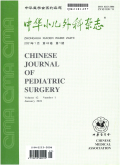三种方法治疗儿童Delee B型肱骨远端经骺板骨折的疗效比较
Comparing clinical efficacies among three therapeutic approaches for Delee type-B fracture-separation of distal humeral epiphysiolysis in children
摘要目的 比较闭合复位、闭合复位内固定与有限切开复位内固定治疗儿童Delee B型肱骨远端经骺板骨折的疗效.方法 回顾性分析2008年1月至 2015年6月收治并获随访的36例儿童Delee B型肱骨远端经骺板骨折患儿资料,其中闭合复位组(闭合复位石膏固定)7例,男6例,女1例;平均年龄21个月.闭合复位内固定组(闭合复位克氏针内固定)11例,男8例,女3例;平均年龄23个月.有限切开复位内固定组(行小切口有限切开复位克氏针内固定)18例,男12例,女6例;平均年龄22.5个月.比较三组患儿术后1年肘关节功能及患侧与健侧提携角差别.结果 所有患儿获得12~60个月(平均26个月)随访.所有患儿均在术后4周获骨折临床愈合.术后1年时,按照Flynn肘关节评分标准评定疗效:闭合复位组优良率57.1%(4/7),闭合复位内固定组81.8%(9/11),有限切开复位内固定组100%(18/18).三组患儿患侧肘关节提携角与健侧差别分别为(17.4±5.2)°、(5.6±1.8)°、(3.5±0.8)°.三组比较及组间两两比较差异均有统计学意义(P<0.05).闭合复位组3例和闭合复位内固定组1例均因肘内翻行髁上截骨术.三组均无骨折延迟愈合、骨筋膜室综合征及医源性血管神经损伤等并发症发生.结论 治疗儿童Delee B型肱骨远端经骺板骨折,行有限切开复位经皮克氏针内固定,与闭合复位、闭合复位内固定相比,可获得更好的疗效,患侧后遗肘内翻程度更低.
更多相关知识
abstractsObjective To compare the clinical efficacies of closed reduction,closed reduction & internal fixation,limited open reduction & internal fixation for Delee type-B fracture-separation of distal humeral epiphysiolysis in children.Methods The clinical data of 36 children with Delee type-B fracture-eparation of distal humeral epiphysiolysis from January 2008 to June 2015 were retrospectively analyzed.The approaches were closed reduction (n=7),closed reduction & internal fixation (n=11) and open reduction via a limited medial or lateral incision & internal fixation (n=18).In closed reduction group,there were 6 boys and 1 girl with a mean age of 21 months;in closed reduction & internal fixation group,8 boys and 3 girls with a mean age of 23 months;in limited open reduction group,12 boys and 6 girls with a mean age of 22.5 months.Three groups were compared with regards to Flynn elbow scoring and carrying angle difference between affected side and contralateral side at 1 year postoperation.Results During a mean follow-up period of 26 (12-60) months,all fractures achieved clinical healing at 4 weeks postoperation.By the Flynn elbow scoring at 1 year postoperation,the good-to-excellent rate was 57.1% (4/7) in closed reduction group,81.8% (9/11) in closed reduction & internal fixation group and 100% (18/18) in limited open reduction group with significant differences (P<0.05).The carrying angle difference between affected and contralateral sides at 1 year postoperation were 17.40±5.20,5.60±1.80 and 3.50±0.80 with significant differences (P<0.05).Three cases in closed reduction group and 1 case in closed reduction & internal fixation group required supracondylar osteotomy for elbow varus.No delayed union,compartment syndrome or iatrogenic vascular or nervous lesions occurred in all groups.Conclusions For Delee type-B fracture-separation of distal humeral epiphysiolysis in children,as compared with closed reduction and closed reduction & internal fixation groups,limited open reduction & internal fixation may achieve optimal functional outcomes and has the smallest carrying angle difference between affected and contralateral sides.Limited open reduction is indicated when closed reduction fails in patients with obvious ossification center of capitellum and metaphyseal fragment.Closed reduction & internal fixation may obtain good functional outcomes with satisfactory reduction or cubitus varus with unsatisfactory reduction.Closed reduction yields a high probability of cubitus varus and a poor efficacy.
More相关知识
- 浏览152
- 被引5
- 下载160


相似文献
- 中文期刊
- 外文期刊
- 学位论文
- 会议论文



 换一批
换一批 换一批
换一批



